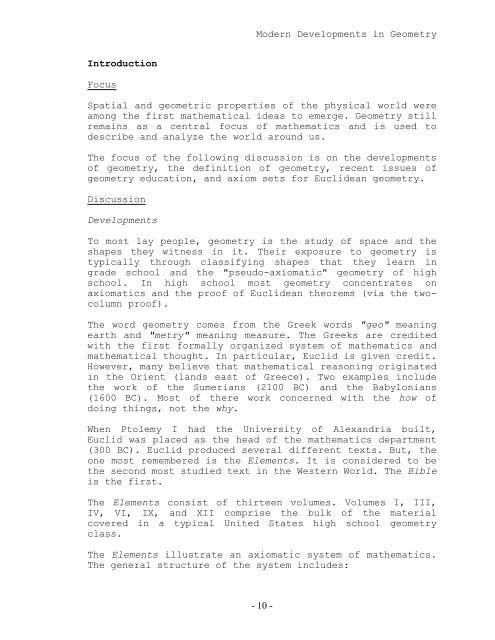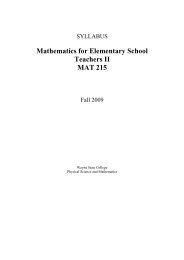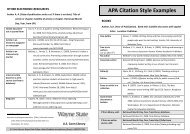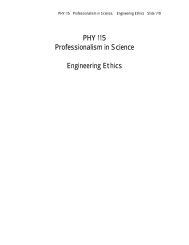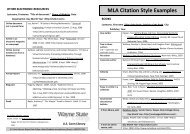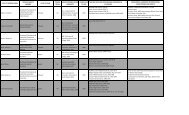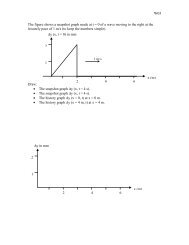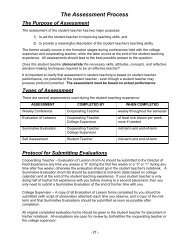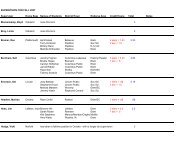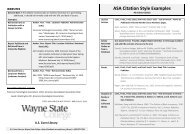Modern Developments in Geometry - 10 - Introduction Focus Spatial ...
Modern Developments in Geometry - 10 - Introduction Focus Spatial ...
Modern Developments in Geometry - 10 - Introduction Focus Spatial ...
Create successful ePaper yourself
Turn your PDF publications into a flip-book with our unique Google optimized e-Paper software.
<strong>Modern</strong> <strong>Developments</strong> <strong>in</strong> <strong>Geometry</strong><br />
<strong>Introduction</strong><br />
<strong>Focus</strong><br />
<strong>Spatial</strong> and geometric properties of the physical world were<br />
among the first mathematical ideas to emerge. <strong>Geometry</strong> still<br />
rema<strong>in</strong>s as a central focus of mathematics and is used to<br />
describe and analyze the world around us.<br />
The focus of the follow<strong>in</strong>g discussion is on the developments<br />
of geometry, the def<strong>in</strong>ition of geometry, recent issues of<br />
geometry education, and axiom sets for Euclidean geometry.<br />
Discussion<br />
<strong>Developments</strong><br />
To most lay people, geometry is the study of space and the<br />
shapes they witness <strong>in</strong> it. Their exposure to geometry is<br />
typically through classify<strong>in</strong>g shapes that they learn <strong>in</strong><br />
grade school and the "pseudo-axiomatic" geometry of high<br />
school. In high school most geometry concentrates on<br />
axiomatics and the proof of Euclidean theorems (via the twocolumn<br />
proof).<br />
The word geometry comes from the Greek words "geo" mean<strong>in</strong>g<br />
earth and "metry" mean<strong>in</strong>g measure. The Greeks are credited<br />
with the first formally organized system of mathematics and<br />
mathematical thought. In particular, Euclid is given credit.<br />
However, many believe that mathematical reason<strong>in</strong>g orig<strong>in</strong>ated<br />
<strong>in</strong> the Orient (lands east of Greece). Two examples <strong>in</strong>clude<br />
the work of the Sumerians (2<strong>10</strong>0 BC) and the Babylonians<br />
(1600 BC). Most of there work concerned with the how of<br />
do<strong>in</strong>g th<strong>in</strong>gs, not the why.<br />
When Ptolemy I had the University of Alexandria built,<br />
Euclid was placed as the head of the mathematics department<br />
(300 BC). Euclid produced several different texts. But, the<br />
one most remembered is the Elements. It is considered to be<br />
the second most studied text <strong>in</strong> the Western World. The Bible<br />
is the first.<br />
The Elements consist of thirteen volumes. Volumes I, III,<br />
IV, VI, IX, and XII comprise the bulk of the material<br />
covered <strong>in</strong> a typical United States high school geometry<br />
class.<br />
The Elements illustrate an axiomatic system of mathematics.<br />
The general structure of the system <strong>in</strong>cludes:<br />
- <strong>10</strong> -
<strong>Modern</strong> <strong>Developments</strong> <strong>in</strong> <strong>Geometry</strong><br />
‰ undef<strong>in</strong>ed terms<br />
‰ def<strong>in</strong>itions<br />
‰ axioms or postulates<br />
‰ theorems<br />
‰ logic<br />
The logic used was developed by Aristotle (384-322 BC).<br />
The system is said to be consistent if no axiom or theorem<br />
contradicts another. An axiom is said to be <strong>in</strong>dependent if<br />
it cannot be derived from the other axioms. F<strong>in</strong>ally, an<br />
axiomatic system is complete if it is impossible to add a<br />
new <strong>in</strong>dependent axiom to it. The geometry described by<br />
Euclid's Elements is believed to be consistent and all<br />
axioms are believed to be <strong>in</strong>dependent. However, this was not<br />
always believed. In particular, several mathematicians<br />
believed Euclid's fifth axiom to be dependent upon the other<br />
axioms.<br />
Kurt Gödel (1906-1978) demonstrated that rich systems such<br />
as arithmetic and Euclidean geometry are <strong>in</strong>heritantly<br />
<strong>in</strong>complete.<br />
This "believed" flaw and several others sparked the<br />
development of several other geometries and pr<strong>in</strong>ciples.<br />
<strong>Modern</strong> geometries are considered to be the collection of<br />
geometries developed after 1800. The emergence of modern<br />
(abstract) algebra also had a major <strong>in</strong>fluence on geometry<br />
dur<strong>in</strong>g this time. Felix Kle<strong>in</strong> used recent f<strong>in</strong>d<strong>in</strong>gs to<br />
classify geometries <strong>in</strong> 1872. Central to his classification<br />
was the concepts of transformations.<br />
Kle<strong>in</strong>'s def<strong>in</strong>ition of a geometry is a study of the<br />
properties of a set W that rema<strong>in</strong> <strong>in</strong>variant when elements<br />
of the set W are subjected to the transformations of some<br />
transformation group > . The geometry is deonoted by KÐWß > Ñ.<br />
The def<strong>in</strong>ition depends on a group as is def<strong>in</strong>ed <strong>in</strong> modern<br />
algebra. The def<strong>in</strong>ition below is the same except knowledge<br />
of groups is not necessary.<br />
A geometry is a pair KœaHßMb<br />
where H is a set of objects<br />
(such as po<strong>in</strong>ts and l<strong>in</strong>es) and M is a relation on the set H<br />
that is both symmetric and reflexive. This is to say that if<br />
Bß C − H then:<br />
‰ BMC CMB<br />
implies<br />
‰ BMB a B − H<br />
- 11 -
<strong>Modern</strong> <strong>Developments</strong> <strong>in</strong> <strong>Geometry</strong><br />
The studies done after 1800 <strong>in</strong>cluded geometric<br />
transformations, extension of Euclidean geometry <strong>in</strong> the<br />
subject of triangles and circles, <strong>in</strong>vention of projective<br />
geometry, and discoveries of non-Euclidean geometries.<br />
Riemannian geometry was <strong>in</strong>strumental <strong>in</strong> E<strong>in</strong>ste<strong>in</strong>'s<br />
establish<strong>in</strong>g general relativity. Quantum geometry has come<br />
to the forefront dur<strong>in</strong>g the last 20 years. It <strong>in</strong>volves <strong>10</strong><br />
spatial dimensions and 1 time dimension. This geometry shows<br />
promise <strong>in</strong> unifiy<strong>in</strong>g general relativity and quantum<br />
mechanics, as well as provid<strong>in</strong>g the ultimate theory for<br />
describ<strong>in</strong>g the cosmos.<br />
Reform<br />
<strong>Geometry</strong> (usually considered Euclidean geometry) has itself<br />
undergone considerable change, as previously discussed.<br />
Several <strong>in</strong>fluential scholars have made contributions to this<br />
change. David Hilbert is probably the most important of<br />
these people dur<strong>in</strong>g the twentieth century. His postulation<br />
of Euclidean geometry is widely used <strong>in</strong> geometry classrooms<br />
today. So to are G.D. Birkhoff's short list of axioms.<br />
Another area that has seen great change recently is the<br />
<strong>in</strong>struction of geometry. <strong>Geometry</strong> education has experienced<br />
two major reforms dur<strong>in</strong>g the last century. The School<br />
Mathematics Study Group (SMSG) and the <strong>Geometry</strong>'s Future<br />
conference.<br />
The SMSG was a project to revise the K-12 mathematics<br />
curriculum. The National Science Foundation (NSF) sponsored<br />
it and work began <strong>in</strong> 1958 under the leadership of Edward G.<br />
Begle of Yale University. The material developed for<br />
geometry still rema<strong>in</strong>s popular. The SMSG postulate set is<br />
also still used.<br />
The <strong>Geometry</strong>'s Future conference highlighted three ma<strong>in</strong><br />
concepts.<br />
‰ New approaches <strong>in</strong> concepts are to be supported by<br />
reformed pedagogy.<br />
‰ Computer technology is to be <strong>in</strong>corporated <strong>in</strong>to the course<br />
material.<br />
‰ Students are expected to understand more about<br />
mathematics and its connections, and be able to express<br />
these understand<strong>in</strong>gs verbally and <strong>in</strong> writ<strong>in</strong>g.<br />
- 12 -
<strong>Modern</strong> <strong>Developments</strong> <strong>in</strong> <strong>Geometry</strong><br />
Specific goals from the proceed<strong>in</strong>gs of the conference<br />
<strong>in</strong>clude;<br />
‰ use of an experimental and <strong>in</strong>ductive po<strong>in</strong>t of view,<br />
‰ applications of geometry,<br />
‰ <strong>in</strong>clusion of recent developments,<br />
‰ the use of figures and diagrams,<br />
‰ the use of physical models,<br />
‰ collaborative learn<strong>in</strong>g, and<br />
‰ an emphasis on transformations.<br />
The dist<strong>in</strong>ction between the mathematics of geometry and<br />
physical geometry is important. The mean<strong>in</strong>g of and examples<br />
of mathematical proofs is very important.<br />
These f<strong>in</strong>d<strong>in</strong>gs are also supported by the National Council of<br />
Teachers of Mathematics (NCTM) as expressed <strong>in</strong> both<br />
Curriculum and Evaluation Standards for School Mathematics<br />
(1989) and Pr<strong>in</strong>ciples and Standards for School Mathematics<br />
(2000).<br />
Standard 7 of Curriculum and Evaluation Standards for School<br />
Mathematics (1989) refers to the study of geometry<br />
synthetically, and Standard 8 refers to the study of<br />
geometry algebraically. The Standards also advocates for the<br />
<strong>in</strong>clusion of synthetic, coord<strong>in</strong>ate and transformational<br />
geometry <strong>in</strong> high school geometry.<br />
The Pr<strong>in</strong>ciples and Standards for School Mathematics (2000)<br />
ma<strong>in</strong>ta<strong>in</strong>s the importance of geometry <strong>in</strong> the P-12th grade<br />
mathematics curriculum. It <strong>in</strong>cludes geometry as one of its<br />
major bands of study. The focus of this emphasizes the<br />
students learn<strong>in</strong>g to --<br />
‰ analyze characteristics and properties of two- and threedimensional<br />
geometric shapes and develop mathematical<br />
arguments about geometric relationships;<br />
‰ specify locations and describe spatial relationships<br />
us<strong>in</strong>g coord<strong>in</strong>ate geometry and other representational<br />
systems;<br />
‰ apply transformations and use symmetry to analyze<br />
mathematical situations;<br />
‰ use visualization, spatial reason<strong>in</strong>g, and geometric<br />
model<strong>in</strong>g to solve problems.<br />
State Standards<br />
Several states (<strong>in</strong>clud<strong>in</strong>g Nebraska) have created or modified<br />
a set of mathematics standards <strong>in</strong> response to the No Child<br />
Left Beh<strong>in</strong>d Act (NCLBA). Nebraska had already started work<br />
- 13 -
<strong>Modern</strong> <strong>Developments</strong> <strong>in</strong> <strong>Geometry</strong><br />
on its mathematics standards and assessments before NCLBA<br />
was enacted. The state chose to cont<strong>in</strong>ue <strong>in</strong> the direction<br />
that it was headed and make the standards and assessments<br />
work with NCLBA.<br />
NEBRASKA EIGHTH AND TWELTH GRADE GEOMETRY STANDARDS<br />
8.4 GEOMETRY/SPATIAL CONCEPTS<br />
8.4.1 By the end of eighth grade, students will identify,<br />
describe, compare, and classify two- and three<br />
dimensional geometric figures - plane figures like<br />
polygons and circles; solid figures like prisms,<br />
pyramids, cones, spheres, and cyl<strong>in</strong>ders; l<strong>in</strong>es, l<strong>in</strong>e<br />
segments, rays, angles, parallel and perpendicular l<strong>in</strong>es.<br />
8.4.2 By the end of eighth grade, students will use<br />
geometric properties, the Pythagorean theorem, and the<br />
relationships of congruence, similarity, and symmetry.<br />
8.4.3 By the end of eighth grade, students will use<br />
formulas to solve problems <strong>in</strong>volv<strong>in</strong>g perimeter and area<br />
of a square, rectangle, parallelogram, trapezoid and<br />
triangle, as well as the area and circumference of<br />
circles.<br />
8.4.4 By the end of eighth grade, students will solve<br />
problems given formulas for volume and surface area of<br />
rectangular prisms, cyl<strong>in</strong>ders, and cones.<br />
8.4.5 By the end of eighth grade, students will apply<br />
transformations to two- and three-dimensional geometric<br />
figures.<br />
Example <strong>in</strong>dicator:<br />
• Draw geometric figures us<strong>in</strong>g translations or slides,<br />
rotations or turns, reflections or flips, and scale.<br />
8.4.6 By the end of eighth grade, students will use<br />
geometric terms and representations to describe the<br />
physical world.<br />
12.4 GEOMETRY/SPATIAL CONCEPT<br />
12.4.1 By the end of twelfth grade, students will<br />
calculate perimeter and area of two-dimensional shapes<br />
and surface area and volume of three-dimensional shapes.<br />
12.4.2 By the end of twelfth grade, students will create<br />
geometric models to describe the physical world.<br />
Example <strong>in</strong>dicators:<br />
• Create perspective draw<strong>in</strong>g.<br />
• Create scale models.<br />
12.4.3 By the end of twelfth grade, students will<br />
evaluate characteristics and properties of two- and<br />
three-dimensional geometric shapes.<br />
- 14 -
<strong>Modern</strong> <strong>Developments</strong> <strong>in</strong> <strong>Geometry</strong><br />
Example <strong>in</strong>dicators:<br />
• Classify and compare attributes of two- and threedimensional<br />
shapes.<br />
• Classify shapes <strong>in</strong> terms of congruence and<br />
similarity and apply these relationships.<br />
• Determ<strong>in</strong>e the effects of chang<strong>in</strong>g dimensions on<br />
perimeter, area, and volume.<br />
• Investigate and deduce geometric properties us<strong>in</strong>g<br />
transformations such as translations, rotations, and<br />
reflections.<br />
12.4.4 By the end of twelfth grade, students will apply<br />
coord<strong>in</strong>ate geometry to locate and describe objects<br />
algebraically.<br />
Example <strong>in</strong>dicators:<br />
• Graph a geometric shape and determ<strong>in</strong>e the slope of<br />
the sides.<br />
• Identify the miss<strong>in</strong>g vertices of a polygon.<br />
12.4.5 By the end of twelfth grade, students will apply<br />
right triangle trigonometry to f<strong>in</strong>d length and angle<br />
measures.<br />
12.4.6 By the end of twelfth grade, students will apply<br />
geometric properties to solve problems.<br />
Example <strong>in</strong>dicator:<br />
• F<strong>in</strong>d miss<strong>in</strong>g angles and lengths of geometric shapes<br />
us<strong>in</strong>g geometric properties. (Properties may <strong>in</strong>clude<br />
but are not limited to similarity, parallel and<br />
l<strong>in</strong>e-transversal).<br />
12.4.7 By the end of twelfth grade, students will apply<br />
deductive reason<strong>in</strong>g to arrive at a conclusion.<br />
Example <strong>in</strong>dicators:<br />
• Justify steps when solv<strong>in</strong>g an algebraic equation<br />
us<strong>in</strong>g properties of real numbers.<br />
• Use logic statements, paragraph proof, two-column<br />
proof, or algebraic proof to arrive at a conclusion.<br />
Axiom Sets<br />
EUCLID'S FIRST FIVE AXIOMS<br />
Axiom 1. A l<strong>in</strong>e may be drawn between any two po<strong>in</strong>ts.<br />
Axiom 2. A segment of any length may be constructed <strong>in</strong> any<br />
l<strong>in</strong>e.<br />
Axiom 3. A circle of any radius and center may be drawn.<br />
Axiom 4. All right angles are congruent.<br />
Axiom 5. Through a po<strong>in</strong>t E not on l<strong>in</strong>e 7 (such that E and<br />
7 are on the same plane), exactly one l<strong>in</strong>e may be<br />
drawn parallel to 7.<br />
- 15 -
<strong>Modern</strong> <strong>Developments</strong> <strong>in</strong> <strong>Geometry</strong><br />
SMSG POSTULATE SET<br />
POSTULATE 1. Given any two dist<strong>in</strong>ct po<strong>in</strong>ts there is exactly<br />
one l<strong>in</strong>e that conta<strong>in</strong>s them.<br />
POSTULATE 2. ÐThe Distance Postulate Ñ To every pair of<br />
dist<strong>in</strong>ct po<strong>in</strong>ts there corresponds a unique positive<br />
number. This number is called the distance between the<br />
two po<strong>in</strong>ts.<br />
POSTULATE 3. ÐThe Ruler Postulate Ñ The po<strong>in</strong>ts of a l<strong>in</strong>e can<br />
be placed <strong>in</strong> a correspondence with the real numbers<br />
such that:<br />
1. To every po<strong>in</strong>t of the l<strong>in</strong>e there corresponds exactly<br />
one real number,<br />
2. To every real number there corresponds exactly one<br />
po<strong>in</strong>t of the l<strong>in</strong>e, and<br />
3. The distance between two dist<strong>in</strong>ct po<strong>in</strong>ts is the<br />
absolute value of the difference of the<br />
correspond<strong>in</strong>g real numbers.<br />
POSTULATE 4. ÐThe Ruler Placement Postulate Ñ Given two<br />
po<strong>in</strong>ts T and U of a l<strong>in</strong>e, the coord<strong>in</strong>ate system can be<br />
chosen <strong>in</strong> such a way that the coord<strong>in</strong>ate of T is zero<br />
and the coord<strong>in</strong>ate of U is positive.<br />
POSTULATE 5.<br />
(a) Every plane conta<strong>in</strong>s at least three non-coll<strong>in</strong>ear<br />
po<strong>in</strong>ts.<br />
(b) Space conta<strong>in</strong>s at least four non-coplanar po<strong>in</strong>ts.<br />
POSTULATE 6. If two po<strong>in</strong>ts lie <strong>in</strong> a plane, then the l<strong>in</strong>e<br />
conta<strong>in</strong><strong>in</strong>g these po<strong>in</strong>ts lies <strong>in</strong> the same place.<br />
POSTULATE 7. Any three po<strong>in</strong>ts lie <strong>in</strong> at least one plane, and<br />
any three non-coll<strong>in</strong>ear po<strong>in</strong>ts lie <strong>in</strong> exactly one<br />
plane.<br />
POSTULATE 8. If two planes <strong>in</strong>tersect, then that <strong>in</strong>tersection<br />
is a l<strong>in</strong>e.<br />
POSTULATE 9. ÐThe Plane Separation Postulate Ñ Given a l<strong>in</strong>e<br />
and a plane conta<strong>in</strong><strong>in</strong>g it, the po<strong>in</strong>ts of the plane that<br />
do not lie on the l<strong>in</strong>e form two sets such that:<br />
1. Each of the sets is convex and<br />
2. If T is <strong>in</strong> one set and U is <strong>in</strong> the other, then<br />
segment TU <strong>in</strong>tersects the l<strong>in</strong>e.<br />
POSTULATE <strong>10</strong>. ÐThe Space Separation Postulate Ñ The po<strong>in</strong>ts of<br />
space that do not lie <strong>in</strong> a given plane form two sets<br />
such that:<br />
1. Each of the sets is convex and<br />
2. If T is <strong>in</strong> one set and U is <strong>in</strong> the other, then<br />
segment TU <strong>in</strong>tersects the l<strong>in</strong>e.<br />
POSTULATE 11. ÐThe Angle Measurement Postulate Ñ To every<br />
angle there corresponds a real number between 0° and<br />
180°.<br />
- 16 -
<strong>Modern</strong> <strong>Developments</strong> <strong>in</strong> <strong>Geometry</strong><br />
⎯→<br />
POSTULATE 12. ÐThe Angle Construction Postulate Ñ Let EF be<br />
a ray on the edge of the half-plane L . For every <<br />
⎯→<br />
between 0° and 180° there is exactly one ray ET , with<br />
T <strong>in</strong> L such that 7nTEF œ < .<br />
POSTULATE 13. ÐThe Angle Addition Postulate Ñ If H is a po<strong>in</strong>t<br />
<strong>in</strong> the <strong>in</strong>terior of nFEG, then 7nFEG œ 7nFEH 7nHEGÞ<br />
POSTULATE 14. ÐThe Supplement Postulate Ñ If two angles form<br />
a l<strong>in</strong>ear pair, then they are supplementary.<br />
POSTULATE 15. ÐThe SAS Postulate Ñ Given a one-to-one<br />
correspondence between two triangles (or between a<br />
triangle and itself). If two sides and the <strong>in</strong>cluded<br />
angle of the first triangle are congruent to the<br />
correspond<strong>in</strong>g parts of the second triangle, then the<br />
correspondence is congruence.<br />
POSTULATE 16. ÐThe Parallel Postulate Ñ Through a given<br />
external po<strong>in</strong>t there is at most one l<strong>in</strong>e parallel to a<br />
given l<strong>in</strong>e.<br />
POSTULATE 17. To every polygonal region there corresponds a<br />
unique positive real number called its area.<br />
POSTULATE 18. If two triangles are congruent, then the<br />
triangular regions have the same area.<br />
POSTULATE 19. Suppose that the region R is the union of two<br />
regions V" and V# . If V" and V#<br />
<strong>in</strong>tersect at most <strong>in</strong> a<br />
f<strong>in</strong>ite number of segments and po<strong>in</strong>ts, then the area of<br />
V is the sum of the areas of V" and V#<br />
.<br />
POSTULATE 20. The area of a rectangle is the product of the<br />
length of its base and the length of its altitude.<br />
POSTULATE 21. The volume of a rectangular parallelepiped is<br />
equal to the product of the length of its altitude and<br />
the area of its base.<br />
POSTULATE 22. ÐCavalieri's Pr<strong>in</strong>ciple Ñ Given two solids and a<br />
plane. If for every plane that <strong>in</strong>tersects the solids<br />
and is parallel to the given plane the two<br />
<strong>in</strong>tersections determ<strong>in</strong>e regions that have the same<br />
area, then the two solids have the same volume.<br />
HILBERT'S AXIOM SET<br />
I. Axioms of Incidence (Connection)<br />
Postulate I.1 Through any two dist<strong>in</strong>ct po<strong>in</strong>ts E, F, there<br />
is a l<strong>in</strong>e, 7.<br />
Postulate I.2 Through any two dist<strong>in</strong>ct po<strong>in</strong>ts E, F, there<br />
is not more than one l<strong>in</strong>e, 7.<br />
Postulate I.3 There exists at least two po<strong>in</strong>ts on any given<br />
l<strong>in</strong>e. There exists at least three po<strong>in</strong>ts that do not<br />
lie on a given l<strong>in</strong>e.<br />
- 17 -
<strong>Modern</strong> <strong>Developments</strong> <strong>in</strong> <strong>Geometry</strong><br />
Postulate I.4 For a set of three po<strong>in</strong>ts ÖEßFßG× that do not<br />
lie on the same l<strong>in</strong>e, there exists a plane T that<br />
conta<strong>in</strong>s each of the po<strong>in</strong>ts <strong>in</strong> the set. For every plane<br />
there exists at least one po<strong>in</strong>t which it conta<strong>in</strong>s.<br />
Postulate I.5 For a set of three po<strong>in</strong>ts ÖEßFßG× that do not<br />
all lie on the same l<strong>in</strong>e, there exists only one plane T<br />
that conta<strong>in</strong>s each of the po<strong>in</strong>ts <strong>in</strong> the set.<br />
Postulate I.6 If two po<strong>in</strong>ts Eß F of a l<strong>in</strong>e, 7, lie <strong>in</strong> a<br />
plane, T, then every po<strong>in</strong>t <strong>in</strong> 7 lies <strong>in</strong> T.<br />
Postulate I.7 If two planes Tß U have a po<strong>in</strong>t E <strong>in</strong> common,<br />
then they have at least one other po<strong>in</strong>t, F, <strong>in</strong> common.<br />
Postulate 1.8 There exist at least four po<strong>in</strong>ts which do not<br />
lie <strong>in</strong> a plane.<br />
II. Axioms of Order<br />
Postulate II.1 If a po<strong>in</strong>t F lies between po<strong>in</strong>ts E and G,<br />
then the po<strong>in</strong>ts ÖEßFßG× are three dist<strong>in</strong>ct po<strong>in</strong>ts on<br />
the same l<strong>in</strong>e and F lies between G and E.<br />
Postulate II.2 Given two po<strong>in</strong>ts Eß G, a po<strong>in</strong>t F exists on<br />
←→<br />
the l<strong>in</strong>e EG such that G lies between E and F .<br />
Postulate II.3 Given any three po<strong>in</strong>ts ÖEßFßG× of a l<strong>in</strong>e,<br />
one and only one of the po<strong>in</strong>ts is between the other<br />
two.<br />
Postulate II.4 Given three po<strong>in</strong>ts ÖEßFßG× that do not lie<br />
on a l<strong>in</strong>e and given a l<strong>in</strong>e, 7, that lies <strong>in</strong> the plane<br />
EFG which does not <strong>in</strong>tersect any of the po<strong>in</strong>ts EßFßG:<br />
if the l<strong>in</strong>e 7 passes through a po<strong>in</strong>t of the segment<br />
EF, it also passes through a po<strong>in</strong>t <strong>in</strong> the segment EG<br />
or through a po<strong>in</strong>t <strong>in</strong> the segment FG.<br />
III. Axioms of Congruence<br />
Postulate III.1 Given two po<strong>in</strong>ts Eß F on a l<strong>in</strong>e 7 and given<br />
a po<strong>in</strong>t<br />
w<br />
E on a or another l<strong>in</strong>e<br />
w<br />
7, there exists a<br />
w<br />
po<strong>in</strong>t F<br />
w<br />
on a side of the l<strong>in</strong>e 7 such that EF and EwFw<br />
are congruent.<br />
Postulate III.2 Given segments EF<br />
w w<br />
and EwwFww<br />
such that both<br />
are congruent to the same segment EF, then EwFw z EwwFww<br />
Postulate III.3 Given a l<strong>in</strong>e 7 with segments EF and FG<br />
such that the po<strong>in</strong>t F is the only <strong>in</strong>tersection of the<br />
two po<strong>in</strong>ts and on the same l<strong>in</strong>e or a l<strong>in</strong>e 7 w with<br />
segments EF<br />
w w<br />
and FG<br />
w w<br />
such that the po<strong>in</strong>t<br />
w<br />
F is the<br />
only <strong>in</strong>tersection: if EF z EwFw and FG z FwG<br />
w<br />
then<br />
EG z E G<br />
.<br />
- 18 -
<strong>Modern</strong> <strong>Developments</strong> <strong>in</strong> <strong>Geometry</strong><br />
Postulate III.4 If nEFG is an angle and ⎯⎯→ F w<br />
G w<br />
is a ray,<br />
⎯⎯→<br />
then there is one and only one ray FE<br />
w w on each side<br />
←⎯→<br />
w w w w w<br />
of the l<strong>in</strong>e FG such that nEFG znEFG.<br />
Corollary: Every angle is congruent to itself.<br />
Postulate III.5 (Side-Angle-Side Axiom) Given two triangles<br />
w w w<br />
˜EFG and ˜E F G with congruences such that EF z EwFw,<br />
EG z EwGw w w w w w w<br />
and nFEG z nF E G then ˜EFG z ˜E F G .<br />
IV. Axiom of Parallels<br />
Postulate IV.1 Given a l<strong>in</strong>e 7 and a po<strong>in</strong>t E not on 7,<br />
there is at most one l<strong>in</strong>e <strong>in</strong> the plane that conta<strong>in</strong>s 7<br />
and E that passes through E and does not <strong>in</strong>tersect 7.<br />
V. Axioms of Cont<strong>in</strong>uity<br />
Postulate V.1 (Archimedes Axiom) Given segments EF and GH,<br />
there exists a number 8 such that 8 copies of GH<br />
⎯→<br />
constructed contiguously from E along the ray EF will<br />
pass beyond the po<strong>in</strong>t F.<br />
Postulate V.2 (L<strong>in</strong>e Completeness) There exists no extension<br />
of a set of po<strong>in</strong>ts on a l<strong>in</strong>e with order and congruence<br />
relations that would preserve the relations exist<strong>in</strong>g<br />
among the orig<strong>in</strong>al elements as well as preserv<strong>in</strong>g l<strong>in</strong>e<br />
order and congruence, i.e., Axioms I-III and V.1.<br />
- 19 -


